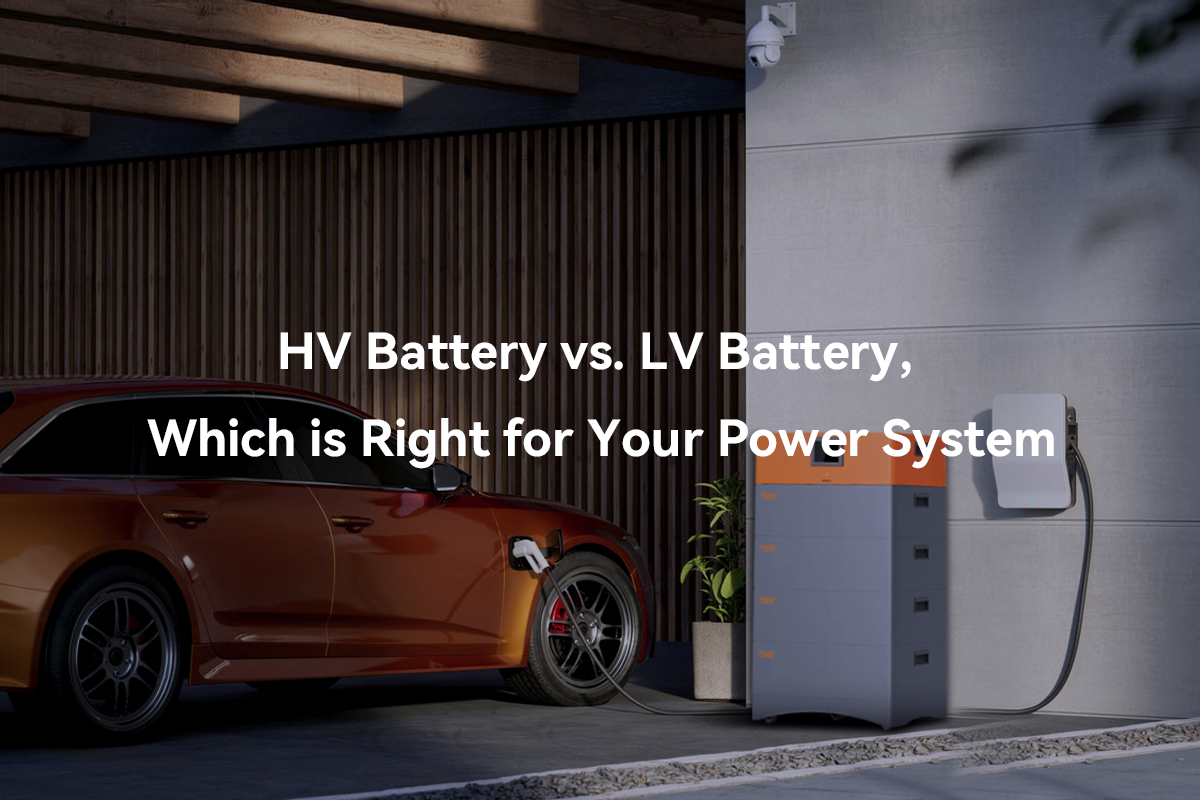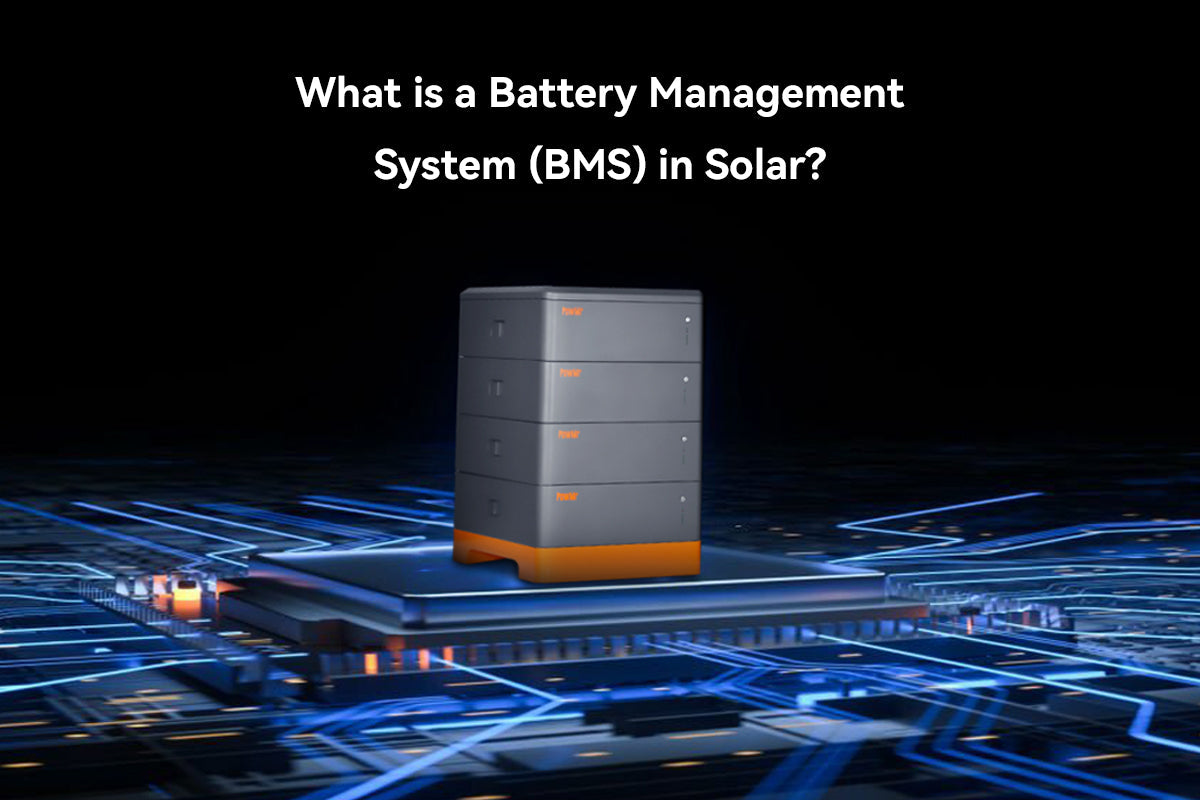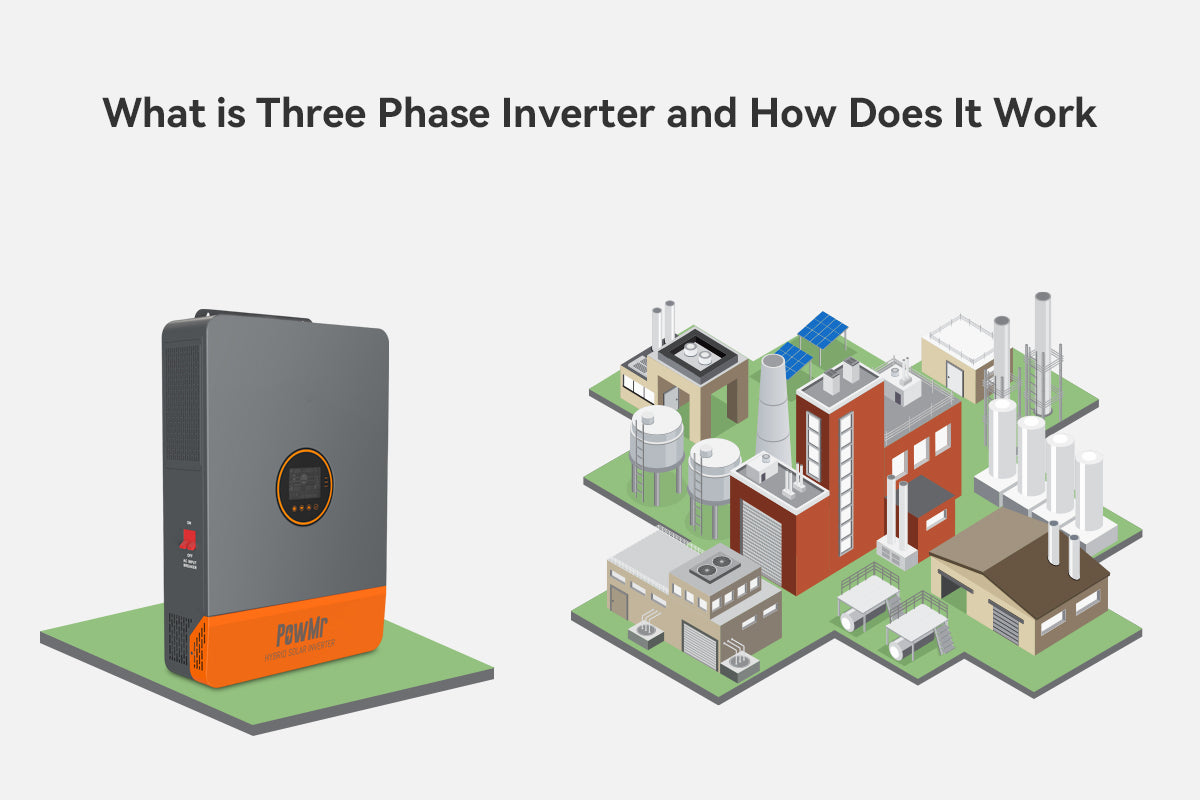แบตเตอรี่ลิเธียม ถูกนำมาใช้กันอย่างแพร่หลายในอุปกรณ์อิเล็กทรอนิกส์ต่างๆ ตั้งแต่สมาร์ทโฟนไปจนถึงการติดตั้งพลังงานแสงอาทิตย์ ในแง่ของแรงดันไฟฟ้า แบตเตอรี่ลิเธียมสำหรับพลังงานแสงอาทิตย์สามารถแบ่งออกเป็น สองประเภท: แบตเตอรี่แรงดันสูง และ แบตเตอรี่แรงดันต่ำ สำหรับผู้ที่ใช้เครื่องใช้ไฟฟ้าที่มีความต้องการพลังงาน 220v/110v ความแตกต่างระหว่างแบตเตอรี่แรงดันสูงและต่ำอาจทำให้เกิดคำถาม.
ในความเป็นจริง แบตเตอรี่แต่ละประเภทมีข้อดีและข้อเสียของตัวเอง แรงดันไฟฟ้าสูงอาจทำให้วงจรเสียหาย ในขณะที่แรงดันไฟฟ้าต่ำอาจส่งผลกระทบต่อประสิทธิภาพได้ ดังนั้นจึงเป็นสิ่งสำคัญที่จะต้องตระหนักถึงความแตกต่างระหว่างแบตเตอรี่ทั้งสองประเภทนี้เพื่อให้เข้าใจลึกซึ้งถึงหลักการทำงานและสถานการณ์การใช้งานของพวกมัน
แรงดันไฟฟ้าคืออะไร
แรงดันไฟฟ้า มักจะ วัดเป็นโวลต์ เป็นปริมาณไฟฟ้าพื้นฐานที่แสดงถึง ความต่างศักย์ไฟฟ้า ระหว่างสองจุดในวงจรไฟฟ้า มันเป็นการวัด แรงหรือความดันที่ขับเคลื่อนกระแสไฟฟ้า ผ่านตัวนำ เช่น สายไฟ ในแง่ที่ง่าย แรงดันไฟฟ้าคือสิ่งที่ผลักดันประจุไฟฟ้า (โดยปกติคืออิเล็กตรอน) ให้เคลื่อนที่ผ่านวงจร.
จินตนาการถึงถังน้ำที่ระดับน้ำแสดงถึงพลังงานศักย์ แทนที่จะเป็นความสูงสัมพัทธ์ของถัง น้ำที่ลึกมากขึ้นในถังจะทำให้ความดันน้ำสูงขึ้น เช่นเดียวกับการเพิ่มแรงดันไฟฟ้าในวงจรที่ผลักดันประจุไฟฟ้า ทำให้การไหลของกระแสไฟฟ้าเป็นไปได้ คล้ายกับน้ำที่ไหลผ่านท่อ.
แบตเตอรี่ HV คืออะไร
"HV Battery" หมายถึง แบตเตอรี่แรงดันสูง ซึ่งออกแบบมาให้ทำงานที่ระดับแรงดันสูงกว่า โดยทั่วไปอยู่ในช่วง 100V ถึง 600V หรือมากกว่า แบตเตอรี่เหล่านี้มักทำงานที่ระดับแรงดันที่สูงกว่าแบตเตอรี่ทั่วไป ลด ระดับกระแส ลดน้อยลง การสูญเสียพลังงานในระหว่างรอบการชาร์จและการปล่อยพลังงาน ซึ่งส่งผลให้ระบบเก็บพลังงานมีประสิทธิภาพและตอบสนองได้ดียิ่งขึ้น.
แบตเตอรี่ LV คืออะไร
"LV Battery" หรือ แบตเตอรี่แรงดันต่ำ หมายถึง แบตเตอรี่ที่ออกแบบมาให้ทำงานที่ระดับแรงดันต่ำ โดยทั่วไป อยู่ในช่วง 2V ถึง 48V แตกต่างจากแบตเตอรี่แรงดันสูง ระบบเหล่านี้มีลักษณะเฉพาะที่แรงดันลดลง ทำให้เหมาะสำหรับการใช้งานต่างๆ เช่น อุปกรณ์อิเล็กทรอนิกส์ขนาดเล็ก ระบบพลังงานแสงอาทิตย์ขนาดเล็ก และการใช้งานในยานยนต์.
แบตเตอรี่ LV กับ HV มีความแตกต่างกันอย่างไร
กำลังผลิตพลังงาน
แบตเตอรี่แรงดันสูง (HV) โดยทั่วไปมีพลังงานที่จ่ายออกสูงกว่ากว่าแบตเตอรี่แรงดันต่ำ (LV) เมื่อ ความจุ Ah เท่ากัน แบตเตอรี่ HV จะช่วยให้การถ่ายโอนพลังงานมีประสิทธิภาพมากขึ้นและ กระแสไฟฟ้าต่ำลง เนื่องจากพลังงาน (P) เท่ากับแรงดัน (V) คูณด้วยกระแส (I) หรือ P = VI การเพิ่มแรงดันจะส่งผลให้กระแสไฟฟ้าลดลง และในทางกลับกัน เมื่อพลังงานคงที่ ดังนั้นระบบ HV สามารถส่งมอบพลังงานเดียวกันด้วยกระแสไฟฟ้าที่ต่ำลง ลดการสูญเสียจากความต้านทานและเพิ่มประสิทธิภาพโดยรวมของระบบ.
ประสิทธิภาพ
แบตเตอรี่ HV เนื่องจากมีลักษณะแรงดันไฟฟ้าที่สูงกว่า จึงช่วยเพิ่มประสิทธิภาพโดยรวมของการถ่ายโอนพลังงาน ความสัมพันธ์ที่ตรงกันข้ามระหว่างแรงดันไฟฟ้าและกระแสในสมการพลังงาน (P = VI) ทำให้ระบบ HV สามารถรักษาพลังงานคงที่ด้วยกระแสที่ต่ำกว่า การ ลดกระแสนี้ช่วยลดการสูญเสียจากความต้านทาน ส่งผลให้ระบบแบตเตอรี่ HV มีประสิทธิภาพสูงขึ้น.
ยกตัวอย่างจาก แบตเตอรี่แบบซ้อนกัน สองก้อนของ PowMr ทั้งสองมีสเปค 51.2V 100Ah โดยการตั้งค่าหนึ่ง รักษา แรงดันต่ำ ที่ 51.2V โดยมีแบตเตอรี่สี่ก้อน ต่อขนาน ขณะที่การตั้งค่าอีกแบบ เชื่อมต่อแบตเตอรี่สี่ก้อน ต่ออนุกรม เพื่อให้ได้ แรงดันสูงกว่า ที่ 204.8V (อ่านบล็อกของเราเกี่ยวกับ การเชื่อมต่อแบตเตอรี่แบบขนาน/อนุกรม)
สมมติว่าทั้งสองระบบจ่าย โหลด 5000W ในช่วงเวลาเดียวกัน แม้ว่าความจุ พลังงาน จะเท่ากันที่ 20.48kWh แต่ระบบ แรงดันสูง สามารถจ่ายพลังงานเดียวกันได้ด้วย กระแสที่ต่ำกว่า.
โดยเฉพาะอย่างยิ่ง กระแสไฟฟ้าสำหรับระบบที่มี แบตเตอรี่ lv อยู่ที่ประมาณ 97.66A ในขณะที่สำหรับระบบ แบตเตอรี่ hv จะอยู่ที่ 24.41A ดังนั้น ระบบแรกจึงมีประสิทธิภาพมากกว่าในแง่ของ การสูญเสียจากความต้านทาน ซึ่งเน้นข้อได้เปรียบของระบบแบตเตอรี่แรงดันสูงในการปรับปรุง ประสิทธิภาพการถ่ายโอนพลังงาน.
อัตราการชาร์จและการปล่อย
แบตเตอรี่ HV มักจะแสดง อัตราการชาร์จและการปล่อยประจุที่สูงกว่า เมื่อเปรียบเทียบกับแบตเตอรี่ LV สาเหตุเป็นเพราะพลังงานคือผลคูณของแรงดันไฟฟ้าและกระแสไฟฟ้า เมื่อระบบ HV ทำงานที่แรงดันไฟฟ้าที่สูงขึ้น พวกเขาสามารถบรรลุระดับพลังงานเดียวกันด้วยกระแสไฟฟ้าที่ต่ำลง ซึ่งช่วยลดการสูญเสียจากความต้านทานและอนุญาตให้มีการชาร์จและการปล่อยประจุที่รวดเร็วขึ้น อัตราการชาร์จและการปล่อยประจุที่รวดเร็วขึ้น เป็นสิ่งจำเป็นในแอปพลิเคชันที่การถ่ายโอนพลังงานอย่างรวดเร็วเป็นสิ่งสำคัญ เช่น ใน ยานยนต์ไฟฟ้าหรือการเสถียรภาพของกริด.
ค่าใช้จ่ายในการลงทุนเริ่มต้นและการติดตั้ง
แบตเตอรี่ HV มักมี ต้นทุนการลงทุนเริ่มต้นที่สูงกว่า แบตเตอรี่ LV ส่วนประกอบและเทคโนโลยีที่จำเป็นสำหรับการจัดการกับแรงดันไฟฟ้าที่สูงกว่าสามารถมีราคาแพงกว่า อย่างไรก็ตาม ความหนาแน่นพลังงานที่สูงขึ้นและประสิทธิภาพของแบตเตอรี่ HV อาจ ชดเชย ต้นทุนเริ่มต้นนี้ โดยเฉพาะในโครงการติดตั้งพลังงานแสงอาทิตย์ขนาดใหญ่ที่ประโยชน์ของแรงดันไฟฟ้าที่สูงกว่าจะชัดเจนมากขึ้น นอกจากนี้ เศรษฐกิจของขนาดอาจมีบทบาท ทำให้ระบบ HV มีความคุ้มค่ามากขึ้นสำหรับโครงการขนาดใหญ่.
ข้อกังวลด้านความปลอดภัย
แบตเตอรี่แรงดันสูง ซึ่งมีระดับแรงดันที่สูงขึ้น มีความเสี่ยงต่อการถูกไฟฟ้าช็อตและอันตรายจากไฟไหม้ที่สูงขึ้น มาตรการความปลอดภัยที่เพียงพอ เช่น การฉนวนและ ระบบจัดการแบตเตอรี่ขั้นสูง (BMS) เป็นสิ่งจำเป็นเพื่อป้องกันอุบัติเหตุ แบตเตอรี่ LV ซึ่งมีแรงดันต่ำกว่า อาจมีโปรโตคอลความปลอดภัยที่ง่ายกว่า.
ความพร้อมใช้งานจำกัด
การผลิตและการจัดจำหน่ายแบตเตอรี่แรงดันสูงอาจเผชิญกับความท้าทายด้านห่วงโซ่อุปทาน ซึ่งส่งผลกระทบต่อความพร้อมใช้งานในบางภูมิภาค ข้อจำกัดนี้อาจส่งผลกระทบต่อการนำรถยนต์ไฟฟ้าหรือการใช้งานอื่น ๆ ที่พึ่งพาแบตเตอรี่แรงดันสูงมาใช้
| ด้าน | แบตเตอรี่แรงดันสูง | แบตเตอรี่ LV |
|---|---|---|
| กำลังผลิตพลังงาน | สูงกว่า | ต่ำกว่า |
| ประสิทธิภาพ | สูงกว่า | ต่ำกว่า |
| อัตราการชาร์จ/การปล่อย | เร็วขึ้น | ช้าลง |
| ความไวต่ออุณหภูมิ | ดีกว่า | ละเอียดอ่อนมากขึ้น |
| อายุการใช้งาน/การบำรุงรักษา | อายุการใช้งานยาวนานขึ้น, การบำรุงรักษาต่ำลง | อายุการใช้งานสั้นลง, การบำรุงรักษาสูงขึ้น |
| การลงทุนเริ่มต้น/การติดตั้ง | ต้นทุนที่สูงขึ้น | ต้นทุนต่ำลง |
| ข้อกังวลด้านความปลอดภัย | ความเสี่ยงที่สูงขึ้น | ความเสี่ยงต่ำ |
| ความพร้อมใช้งานจำกัด | ความท้าทายของห่วงโซ่อุปทาน | มีให้บริการอย่างกว้างขวางมากขึ้น |
บทสรุป - ข้อดีและการใช้งาน
แบตเตอรี่แรงดันสูง (HV) และ แบตเตอรี่แรงดันต่ำ (LV) มีบทบาทที่แตกต่างกันในแอปพลิเคชันต่างๆ โดยแต่ละประเภทได้รับการออกแบบมาเพื่อตอบสนองความต้องการเฉพาะ การเลือกใช้ระหว่างแบตเตอรี่ HV และ LV ขึ้นอยู่กับความต้องการของแอปพลิเคชัน การพิจารณาด้านประสิทธิภาพ และปัจจัยด้านความปลอดภัย.
ข้อดีของแบตเตอรี่ HV
-
การส่งผ่านพลังงานอย่างมีประสิทธิภาพ
แบตเตอรี่ HV มีความโดดเด่นในแอปพลิเคชันที่ การส่งพลังงานระยะไกล มีความสำคัญ เนื่องจากแรงดันไฟฟ้าที่สูงกว่าทำให้สามารถส่งพลังงานด้วยกระแสที่ลดลง ลดการสูญเสียจากความต้านทาน ในระหว่างกระบวนการ. -
ความต้องการพลังงานสูง
แบตเตอรี่แรงดันสูง (HV) เหมาะสำหรับการใช้งานที่ต้องการพลังงานสูงเนื่องจากความสามารถในการ ส่งมอบพลังงานในปริมาณมากได้อย่างรวดเร็ว การออกแบบของพวกเขารวมถึงวัสดุและการจัดเรียงที่ทันสมัยซึ่งช่วยเพิ่มความหนาแน่นของพลังงาน ทำให้สามารถทำงานได้อย่างมีประสิทธิภาพในสถานการณ์ที่มีความต้องการพลังงานสูง. -
ประสิทธิภาพของรถยนต์ไฟฟ้าที่พัฒนาแล้ว
ในบริบทของรถยนต์ไฟฟ้า (EVs) แบตเตอรี่ HV มีบทบาทสำคัญในการช่วยให้สามารถขับขี่ได้ระยะทางที่ยาวขึ้นและ ความสามารถในการเร่งความเร็วที่สูงขึ้น แรงดันไฟฟ้าที่เพิ่มขึ้นช่วยให้การส่งพลังงานไปยังมอเตอร์ไฟฟ้ามีประสิทธิภาพ ส่งผลให้ประสิทธิภาพโดยรวมของรถดีขึ้น.
แอปพลิเคชันที่แบตเตอรี่ HV โดดเด่น
-
การจัดเก็บพลังงานในระดับกริด
แบตเตอรี่ HV มีข้อดีสำหรับระบบจัดเก็บพลังงานขนาดใหญ่ที่เกี่ยวข้องกับกริดไฟฟ้า. -
รถยนต์ไฟฟ้า
แบตเตอรี่ HV เป็นส่วนประกอบที่สำคัญในรถยนต์ไฟฟ้า ช่วยให้ระยะการขับขี่ยาวนานขึ้นและเพิ่มความเร็วในการเร่ง. -
ระบบพลังงานเชิงพาณิชย์และอุตสาหกรรม
การตั้งค่าทางการค้าและอุตสาหกรรมขนาดใหญ่ได้รับประโยชน์จากความสามารถในการจ่ายไฟสูงของแบตเตอรี่ HV สำหรับการจัดเก็บและการใช้พลังงานอย่างมีประสิทธิภาพ.
ข้อดีของแบตเตอรี่ LV
-
ความปลอดภัยและความเรียบง่าย
แบตเตอรี่ LV เป็นที่นิยมในแอปพลิเคชันที่ความปลอดภัยและความเรียบง่ายมีความสำคัญสูงสุด ระดับแรงดันไฟฟ้าที่ต่ำกว่าช่วยลดความเสี่ยงจากอันตรายทางไฟฟ้าและทำให้การออกแบบวงจรอิเล็กทรอนิกส์ที่เกี่ยวข้องง่ายขึ้น. -
การพิจารณาเรื่องพื้นที่และน้ำหนัก
แบตเตอรี่ LV ได้รับความนิยมในสถานการณ์ที่มีข้อจำกัดด้านพื้นที่หรือการพิจารณาน้ำหนักเป็นสิ่งสำคัญ แม้ว่าจะมีประสิทธิภาพการส่งผ่านพลังงานที่ต่ำกว่ากว่าแบตเตอรี่ HV แต่แบตเตอรี่ LV ก็ให้โซลูชันที่คุ้มค่าและเชื่อถือได้สำหรับการใช้งานที่มีความต้องการพลังงานต่ำกว่า.
แอปพลิเคชันที่แบตเตอรี่ LV เป็นตัวเลือกที่ต้องการ
-
ระบบเก็บพลังงานขนาดเล็กสำหรับที่อยู่อาศัย
แบตเตอรี่ LV มักถูกใช้ในระบบที่อยู่อาศัยขนาดเล็กซึ่งความปลอดภัยและความเรียบง่ายเป็นสิ่งสำคัญ -
อุปกรณ์อิเล็กทรอนิกส์พกพา
แบตเตอรี่ LV เหมาะสำหรับการจ่ายพลังงานให้กับอุปกรณ์อิเล็กทรอนิกส์พกพาเนื่องจากคุณสมบัติด้านความปลอดภัยและความประหยัดพื้นที่ -
การติดตั้งนอกกริดที่มีความต้องการพลังงานปานกลาง
ในระบบที่ไม่เชื่อมต่อกับกริดซึ่งมีความต้องการพลังงานปานกลาง แบตเตอรี่ LV ให้โซลูชันที่ใช้งานได้จริงและเชื่อถือได้ โดยคำนึงถึงความปลอดภัย ความเรียบง่าย และข้อจำกัดด้านพื้นที่.



